



Genesus Global Market Report: South East Asia - October 2019
Paul Anderson of Genesus Inc. presents the pork market overview for South East Asia.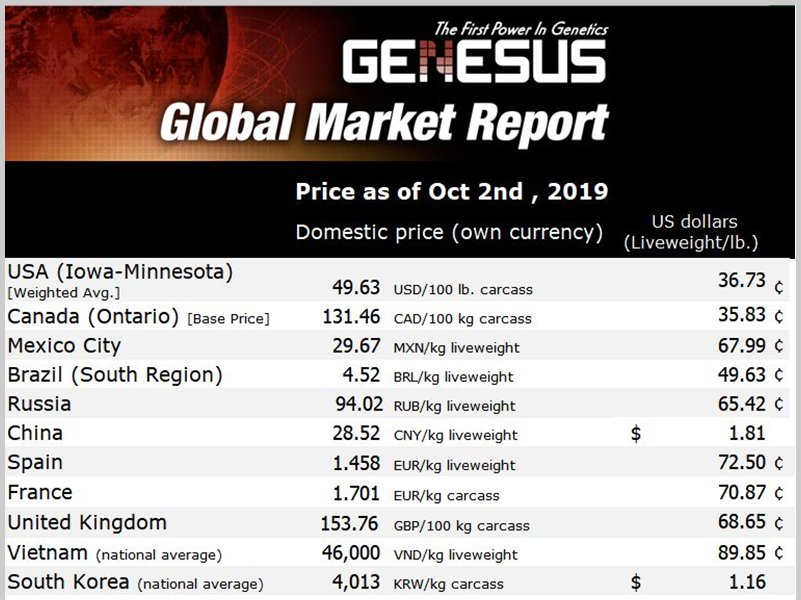
Philippines
According to the Philippine Statistics Authority as of 01 July 2019, the total inventory of swine in the country was estimated at 12.70 million heads. This represents a decrease of 0.6 percent compared with its previous year’s stocks of 12.78 million heads. Population of swine in backyard farms of 8.02 million heads contracted by 1.2 percent from the previous year’s count of 8.12 million heads. On the other hand, stocks in commercial farms at 4.68 million heads expanded by 0.4 percent from the previous year’s level of 4.66 million heads.
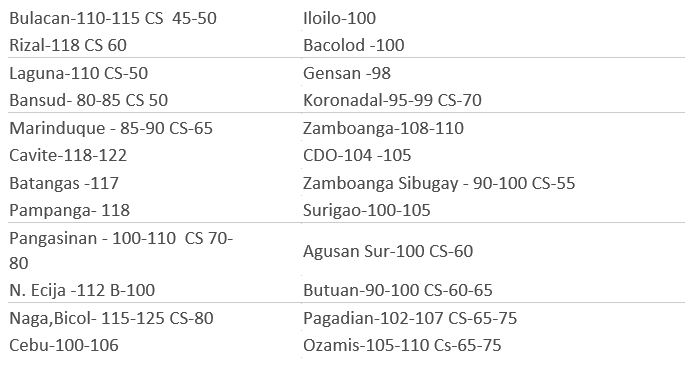
Among the regions, Central Luzon recorded the highest swine inventory of 2.21 million heads. This was followed by CALABARZON and Western Visayas with stocks of 1.53 million heads and 1.23 million heads, respectively. The combined stocks of these three regions accounted for 39.1 percent of the country’s total swine inventory. (Table 2)
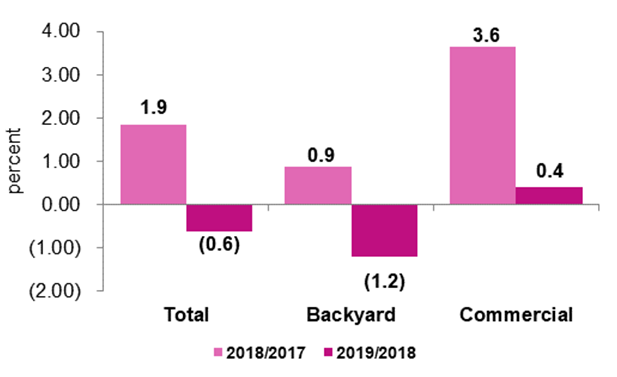
Changes in swine inventory by farm type, Philippines as of 01 July 2017-2019
The total volume of hog production in April to June 2019 was 580.11 thousand metric tons, liveweight. This was 4.1 percent higher compared with the previous year’s level of 557.27 thousand metric tons, liveweight.
Relative to their levels in 2018, 14 regions recorded increases in production. Among these regions, SOCCSKSARGEN reported the highest increment in production of 9.7 percent, from 26.02 thousand metric tons, liveweight in 2018 to 28.55 thousand metric tons, liveweight in 2019.
Among the regions, Central Luzon was the highest producer of hog at 106.00 thousand metric tons, liveweight. This was followed by CALABARZON and Western Visayas with production of 103.43 thousand metric tons and 48.82 thousand metric tons, liveweight, respectively. These three regions contributed 44.5 percent to the country’s total hog production. (Table 1)
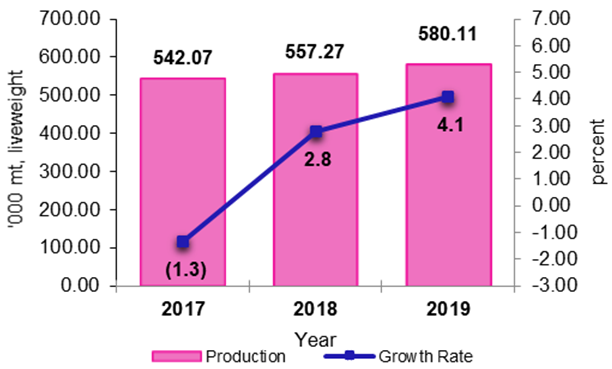
Volume of hog production, Philippines: April - June 2017-2019
The average farmgate price of hogs upgraded for slaughter in April to June 2019 was PhP110.15 per kilogram, liveweight. This was 6.6 percent lower than the average farmgate price level of PhP117.88 per kilogram, liveweight, in 2018.
During the reference period, the highest average farmgate price was recorded in April at PhP110.89 per kilogram, liveweight while the lowest price was noted in June at PhP108.71 per kilogram, liveweight. (Table 3)
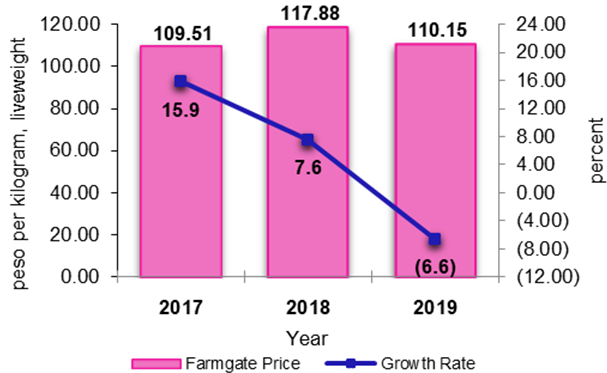
Average farmgate price of hogs upgraded for slaughter, Philippines: 2017 - 2019
On 16 August, the Bureau of Animal Industry (BAI) informed the Department of Agriculture (DA) of an increase in mortality in pigs reared on backyard farms in Rizal province, near Manila. The DA immediately ordered to investigate the affected farms and the collection of blood samples.
The samples were sent to Pirbright's reference laboratory in the UK, and the PCR result has been positive for ASF, as reported by the DA in a statement released on 9th September 2019.
We send our best wishes to our customers and pig farming friends in the Philippines and all the other Countries being devastated by ASF.
Thailand
ASF gets closer to Thailand. Thailand restricts movements of pigs in 18 out of 77 provinces as African Swine Fever (ASF) is getting closer after AFS has hit Myanmar’s Shan State, which is bordering Thailand’s northern province of Chiang Rai.
Myanmar reported to the world animal health organization (OIE) in August that samples of dead pigs found in the state’s Tachileik town contained ASF virus. This incidence prompted Thailand on a high alert because dead pigs from the town were found dumping into a tributary of Mekong River that runs through Tachileik and Chiang Rai.
As a consequence, Thai livestock authorities declared Chiang Rai a high-risk area and restricted movement of pigs within and out of the province. Pigs in farms located along the river and those with poor biosecurity were culled to create a buffer zone along the border and the riverbank.
The similar measure is also taking place in other provinces along the border with Myanmar. One of them is Ratchaburi, which boarders the southern region of Myanmar.
About 100km west of Bangkok, Ratchaburi is Thailand’s largest pig producing hub with nearly two million pigs or about 10% of the country’s pig population.
Earmarked as another high-risk area, some pig farmers in Ratchaburi were hastily selling out their pigs in September, causing the price of live pigs in the province lowest in the country at about USD 1.8/kg. The pig price in Thailand at that time was average around USD 2/kg and highest at USD 2.3/kg in the south.
Thai pork exports on the rise
As Thailand remains free from ASF, it is seeing an increasing order for pork from Hong Kong.
The Thai Swine Raisers Association said in the first six months of the year, Thailand shipped 895 tonnes of pork to the island. This accounts as about 63% of Thai pork exports to Hong Kong in 2018 or about 1408 tonnes.
The association estimates that Thailand would ship 2500 tonnes of pork to Hong Kong this year.
Genesus’ distributor in Thailand joins the bandwagon
Inspired Nutrient, a major distributor of Genesus in Thailand, is teaming up with Bangkok-based pork packer Fast Food All in exporting pork to Hong Kong.
The two parties shipped 300kg of chilled carcasses (cut into three pieces) to a major supermarket chain in Hong Kong in September as a sample.
“The customer in Hong Kong informed us that they were very satisfied with our product sample and they will soon come to inspect our production facility in Thailand,” said Dr Nopparat Bhavabutanon, Managing Director of Inspired Nutrient.
He said the importer from Hong Kong planned to buy about 200 pigs/day. To serve this, Inspired Nutrient will buy live pigs from Trang Wattana Farm in southern Thailand to slaughter and process at Fast Food All’s plant
“We target at Trang Wattana Farm because they use Duroc boar semen from Genesus. As a result, the carcass yield whilst meat quality from their pigs is better than those coming from other genetic sources,” said Dr Nopparat.
Vietnam
Since the confirmation, by the Ministry of Agriculture and Rural Development (MARD), of the first outbreak of ASF on February 19th, 2019, a total of 63 provinces / towns have informed of the presence of outbreaks and more than 4,500,000 pigs have been destroyed.
The pig price of Vietnam go up and down during last four week’s. The reason for seems to be that ASF is still having outbreaks in some regions of Vietnam and the Farmer’s are selling out their pigs down to 40kgs liveweight for slaughter to minimise the financial risk of ASF high mortality or an ASF cull. This is further reducing the stocks of pork in Vietnam which is already forecast to lack some 500,000 tons of pork by the end of 2019.
Due to ASF outbreaks in Vietnam, some farmer’s have switched to produce Poultry and Cattle instead of Pig’s, the result in this is meat price of poultry has moved down a lot.
According to Department of Animal Health, the President visited a farm in Ha Noi which has had an outbreak of ASF, this farm has produced a guide to prevent ASF. Until now, Ha noi have 9,465 backyard farm outbreaks with ASF and 147,700 head of pig already destroy
Pig price of the North is 46,000 – 51,000 vnd/kg, in the Center of Vietnam is 40,000 – 47,000 vnd/kg and the South of Vietnam is 46,000 – 47,500 vnd/kg. The average is 46,000 vnd/kg. Farmer’s are thinking the pig price will go up very fast soon because at this moment the pigs can’t cross the boarder into China but they believe after the 10 Independent days of China, for sure the pig will again commence movement into China thus causing the pig price go up.
Vietnamese pig producers have learnt the crucial role played by biosecurity in pig production, especially in during epidemics such as ASF. The Department of Livestock Production (DLP) said that farms that have done well in biosafety have kept their farms unaffected by the deadly virus. DLP Deputy Director Nguyen Van Trong noted an increasing number of pig farms have been applying strict biosecurity in their farms in the last three years. Biosecurity is thus a prerequisite that localities will consider for restocking allowance.
Agriculture and Rural Development Deputy Minister Phung Duc Tien has asked localities to consider restocking their pig herd to avoid pork shortages at the end of 2019, and especially for the Lunar New Year. Mr Tien also noted that the strict biosecurity now being implemented in many farms to prevent ASF has significantly reduced the number of pigs culled in recent months. Although many localities have not allowed restocking, Mr Tien said that with proper biosecurity protocols, restocking can be viable.
Malaysia
Some supermarkets in Malaysia still had recently manufactured pork products from China on their shelves, a recent investigation by a local newspaper found. Some of the products were produced as recent as March and June 2019 and should not have been imported into the country after the widely imposed ban since September 2018 following the ASF outbreak
Laos
The first outbreak was confirmed in the province of Salavan on June 20th, 2019, and so far, 94 outbreaks have been detected in 15 of its 18 provinces/towns. More than 25,000 pigs have died or been destroyed.
Cambodia
The first outbreak was detected in the province of Ratanakiri on April 2nd, 2019. ASF outbreaks have been detected in 5 provinces: Ratanakiri, Tboung Khmum, Svay Rieng, Takeo and Kandal.
Myanmar: Since the Ministry of Agriculture, Livestock and Irrigation confirmed the first outbreak of ASF on August 1st, 2019, a total of 3 outbreaks have been notified in the state of Shan.
Myanmar is one of the next Countries to develop into commercial pig production, currently more than 95% of the pig population are in backyard farms. Some supermarkets in Malaysia still had recently manufactured pork products from China on their shelves, a recent investigation by a local newspaper found. Some of the products were produced as recent as March and June 2019 and should not have been imported into the country after the widely imposed ban since September 2018 following the ASF outbreak










